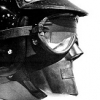I have always loved video games, and would like to start learning the skills that would allow me to pursue a job in game design when I'm older.
Based on your post, "game design" could mean a few things.
It could mean the job of game designer. These are the people who write the rules and mechanics of the games. It is a position many people aspire to, and generally requires several years of game industry experience. Designers are generally artists, programmers, and testers who have demonstrated an ability to come up with fun game mechanics. It is easy to see who would make good game designers: they get into the guts of the rules. They play games like D&D, Magic, and complex board games, and while they are playing they get into passionate arguments about nuance in the rules.
You might also mean more of an art director role. These are the people who determine the look and feel of a game. It is one thing to say a game should look "gritty" or "cute" or "all butterflies and rainbows", or "guts and gore", or whatever. The art director turns that vague general description into something concrete. They also work with artists on what needs to change to meet the artistic style of the game.
I am literally the most computer illiterate, ignorant person you could ever meet when it comes to game design. The only attributes I have are a love of video games and a proficient skill in painting (I've been painting oil and acrylic landscapes seriously for about 3 years now, although I've been involved in art my whole life, and selling for about 1; I believe my artwork has reached a professional level, although I have little experience when it comes to drawing/painting people.
Art is probably a good path for you. The other major paths into game development are programming and QA, but as you are computer illiterate those would likely be a bad fit.
2) What is the process for making art in video games? Can you give me some general steps about how one goes from point A (concept) to point B (physical product)
During design of the game, the art director works with concept artists to come up with how things should feel. A quick search can show the types of drawings made at this phase. Generally the concept artists will spend just a few minutes on each sketch and generate several hundred generic concepts. Some of those will be refined into drawings taking a few hours to complete. Then a small number of those will be turned into nice images that help express the concepts of the game. These concepts define the look of the world.
As specific objects are designed, the game designer and art director may have concept artists come up with concepts of specific items they want in the game. Simply stating that you want a futuristic tank or a cuddly kitten is not enough. Artists may come up with fifty different tank designs. Or for the kitten they will need concepts of the kittens quirks and animation styles.
Everything in the game needs to be created. There is much more than the main characters. There are trees, rocks, bushes, fences, cows, chickens, sheds, outhouses, homes, office buildings, cars, trucks, tanks, guns, grenades, crates, barrels, mailboxes, desks, chairs, lamps, wells, signposts, and on and on and on. Even the small games on smart phones and web pages can require many gigabytes of source material. My current game's art assets folder comes in at just over 200 GB.
When the game is implemented, it will either be done as a 3D game or a 2D game.
In a 3D game, each object is given a 3D model and texture. Generally the game designer will provide some images and a description of what they want.
Models are made out of one or more 3D meshes and one or more textures that lay on the mesh. Many models also include animation rigs, also called bones or joints or skeletons, that enable movement.
When the models are nearing completion, the modeler will work with animators to ensure all the moving parts are modeled good enough for the animator to implement their designs. The animators work with programmers and designers to develop a list of animations that are required. Animators position objects relative to each other and use their art program (usually Maya) to generate animation curves to move things over time.
Yet another art area in 3D games are particles and effects. There is little difference between a severed limb's blood splatter and cute magical sparkles, apart from the art being used in the particle.
For 2D assets, each object is drawn with pixel art.
UI screens are generally 2D pixel art. The artists draw buttons and windows and widgets. Some games require thousands of little images, one image to represent each game object.
Games that are rendered in 2D need to have all the game assets drawn. Some objects only need one or two images that will be flipped and rotated as needed. Player characters may need thousands of images drawn as they walk, run, sit, and do other activities.
In both cases, the artists create the art, and the programmers do their magic to get it in game.
All of the art is reviewed by the art director for aesthetics and style.
Then QA starts finding bugs in the artwork. Models and animations and pixel art will all need adjustments as bugs are found.
3) Where can I learn how to make art for video games? Where do I start? (I have no idea). What should I tackle first?
It looks like you are currently focused on physical art. That is useful because you can understand the concepts of art. Unfortunately it doesn't get the artwork into the computer.
There is only one company to use when it comes to digital art tablets: Wacom.
You need to get comfortable with Wacom tablets. They aren't very expensive, you can get a Wacom Bamboo (a small entry level pen and tablet) new for under $50 if you shop around, or used on ebay for around $25. Professionals will end up with a larger Wacom Intuos that can cost several hundred dollars depending on how large the pad is.
For art software you absolutely must get comfortable with Photoshop, no matter what other tools you use.
If you intend to do any 3D work you also must get comfortable with Maya.
Learning to draw digitally is very different from acrylics.
4) What are the similarities between physical painting and computer artwork?
You still need an eye for what looks good, and you need dexterity. Art theory still applies.
Apart from that, the tools and technologies are radically different. Instead of applying pigment to a surface you click a button and then apply varying amounts of pressure to a stylus on a tablet that is a meter away from the image.
4) What is the difference between programming and coding? (in regards to game design). How hard is it for someone with zero programming/coding experience to learn this? How can I start learning how to program/code, and what should I tackle first?
Why on earth would you want to be a programmer when you described yourself as having no interest in it? Most game artists can look at a screen and say "Yup, it looks like computer code."
5) How do programmers/coders and artists work together? Where do their jobs intersect?
Programmers create a toolchain that gets the art into the game. This is one intersection point. The programmers work with artists to figure out where the assets go, and provide tools that let the artists figure out things like game-friendly texture names, game-friendly slotting position names, geometry states, and other data that doesn't fit directly inside the images. A UI tool might let the artist define what a button is. It might let the artist pick file names for the images of each button state. A 2D animation tool might let the artist specify the size and stride of images on a sprite sheet.
Another area of intersection is determining how animations chain together. This is generally driven by the design of the game and of the objects. Animators need to specify where the loops are. They also need to tag certain animation frames with events so the programmers know when to run certain code. For example if you have an animation of a character turning on a radio there will need to be an animation event on the frame where the button is pressed, so the programmer knows to turn on the music at that point.
There are a few other intersection points. They go to some of the same meetings discussing the designs and reviewing the results. They share the lunchroom and bathrooms and other common areas.
I'd say that on most of the my projects over the years, the artists and programmers actually sit down and work on the same things for perhaps an average of twenty minutes per day. They generally work on very different tasks.






